Agricultural Literacy Curriculum Matrix
Lesson Plan
Understanding MyPlate (Grades 3-5)
Grade Level
Purpose
Students explore appropriate serving sizes and learn how to make healthy dietary decisions by understanding the components of nutrition as illustrated by MyPlate. Grades 3-5
Estimated Time
Materials Needed
Engage:
- Food Models (Click on the blue "view graphic" button to see the PDF. Print these front to back and cut them out for students to see the actual size of servings.) or basket with as many of the following items as you can find: apple, peanut, corn, beans, cantaloupe, green pepper, strawberry, carrot, potato, tomato, eggs, onion, watermelon, popcorn, rice, hot dogs, and ham
Activity 1: Balancing MyPlate
- Small sticky notes or small colored pieces of paper, 5-10 per student
- MyPlate Poster or MyPlate Image
- Paper plates, 1 per student
- Glue or glue sticks
- Crayons or colored pencils
- Scissors
Activity 2: Servings and Portions on MyPlate
- MyPlate Plan webpage
- How to Measure Food Using Your Hand
- Food Models Kit (optional)
- Healthy Choices activity sheet, 1 per student (optional)
Activity 3: Think Your Drink
- Beverage containers
- Think Your Drink chart
Vocabulary
MyPlate: nutritional guide published by the United States Department of Agriculture (USDA); icon depicting a place setting with a plate and glass divided into five food groups
portion size: the amount of a particular food eaten during a meal or snack
serving size: the amount of a particular food listed on that food's Nutrition Facts label along with the calorie and nutrient content
Did You Know?
- Using the Nutrition Facts on food labels will enable you to eat healthier and make wiser food choices. Select foods that are low in fat and sodium.
- The Percent Daily Values (% DV) is a general guide for linking nutrients in one serving of food to their contribution to your total daily diet.
- Most Americans don't receive enough vitamins A and C, potassium, calcium, and iron; therefore select foods with a higher % DV for these nutrients.
- Water can be your best friend. Flavored teas, sodas, sport drinks, and juices can add as much as 400 calories to your meal whereas water has no calories at all and helps you feel full.
- Meals that are cooked and prepared at home rather than purchased at a restaurant have less calories and can be monitored more closely for healthier options.
Background Agricultural Connections
The USDA MyPlate icon uses a familiar and relatable image to help us balance our diets, eating from all five food groups proportionally. MyPlate identifies each of the food groups with a different color and a proportional section of the meal setting. The icon provides a visual reminder to make half of your plate fruits and vegetables. The USDA dietary guidelines include a few more basic recommendations to help Americans make healthy food choices: eat a variety of different fruits and vegetables, make half of your grains whole grains, eat a variety of protein foods, and choose low- and nonfat dairy products. Foods with added fats and sugar should be eaten only occasionally, and processed foods should be eaten in moderation.
The dietary guidelines recognize that the number of servings an individual needs to keep their body healthy will vary by age, sex, and physical activity. In addition to energy (calories), the food we eat also provides us with a variety of vitamins and minerals. These nutrients are important for our bodies to grow and develop in a healthy way. Each kind of food provides some, but not all, of the nutrients your body needs. For this reason, it is difficult for foods in one group to replace foods in another group, and it is important to eat a variety of foods within each group. In addition, the more processed a food is, the fewer nutrients it is likely to have. Some highly processed foods like potato chips and donuts contain lots of calories but few nutrients, so it is best to limit consumption of processed foods.
Though "portion size" and "serving size" are terms often used interchangeably, there is a difference. Knowing the difference makes it easier to compare what you eat to MyPlate's daily recommendations. Portion size is the amount we eat during a meal or snack. Portion sizes can be bigger or smaller than MyPlate serving size equivalents. Serving sizes are listed on the Nutrition Facts panel of food nutrition labels, along with the calorie and nutrient content for a serving. Sereving sizes may be, and often are, different from MyPlate recommendations. While a nutrition label tells us what people might typically eat, it is not a recommendation for how much we should eat. The number of servings in a package is also listed on the nutrition label.It is important to keep in mind that many packages look like single servings but contain two or more servings.
What you drink is as important as what you eat. Soda, energy drinks, and sports drinks are a major source of added sugar in American diets. Sugary drinks contain added calories which may contribute to weight gain and health and dental risks. Nutrition fact labels help us to identify the amount of sugar, calories, and nutrients in our drinks.
Don’t forget that exercise is part of a healthy lifestyle too!
Engage
- Prepare a basket with as many of the following items as you can find: apple, peanut, corn, beans, cantaloupe, green pepper, strawberry, carrot, potato, tomato, eggs, onion, watermelon, popcorn, rice, hot dogs, and ham. You may call on parents or volunteers to help provide these items. As an alternative, you could also use pictures or cards from the Food Models Kit.
- Call on students to choose an item from the basket and tell why they chose this item. Ask the students the following questions to help them connect the food they eat each day to the farm(s) that produce it:
- Do you like to eat this type of vegetable, fruit, or meat?
- Where can you purchase these items?
- How do these items get to the grocery store?
- How are these foods grown?
- Who grows these foods?
- What would you eat if farmers didn't grow these foods?
Explore and Explain
Activity 1: Balancing MyPlate
- Pass out 5-10 small sticky notes (or small colored pieces of paper) to each student.
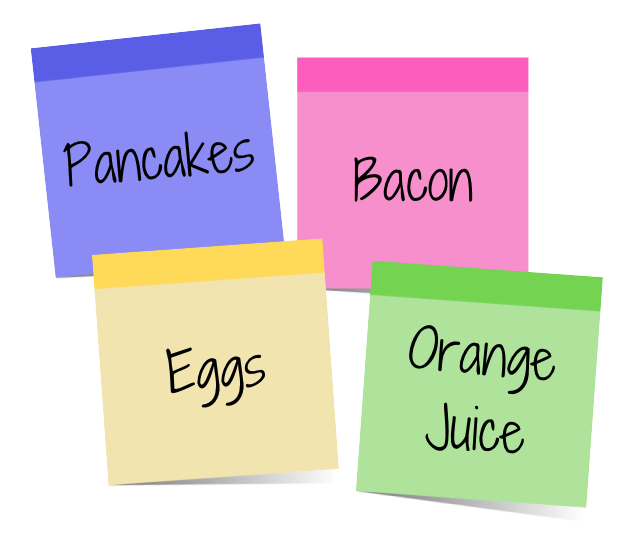
- Ask the students to think of their favorite meal (breakfast, lunch, or dinner).
- Ask the students to write each component of the meal on separate sticky notes (e.g., a pancake breakfast with bacon, eggs, orange juice, and assorted fruit).
- Instruct the students to place their sticky notes to the side.
- Display a MyPlate Poster or a MyPlate Image on the board.
- Review MyPlate with students and discuss the role of nutrition in growth and development.
- Provide each student with a paper plate and various art materials (markers, colored pencils, glue, and scissors).
- Ask the students to create their own replica of MyPlate by sectioning off their paper plate into each of the different food groups (fruits, vegetables, grains, protein, and dairy). Include a paper circle cut-out to the side for dairy.
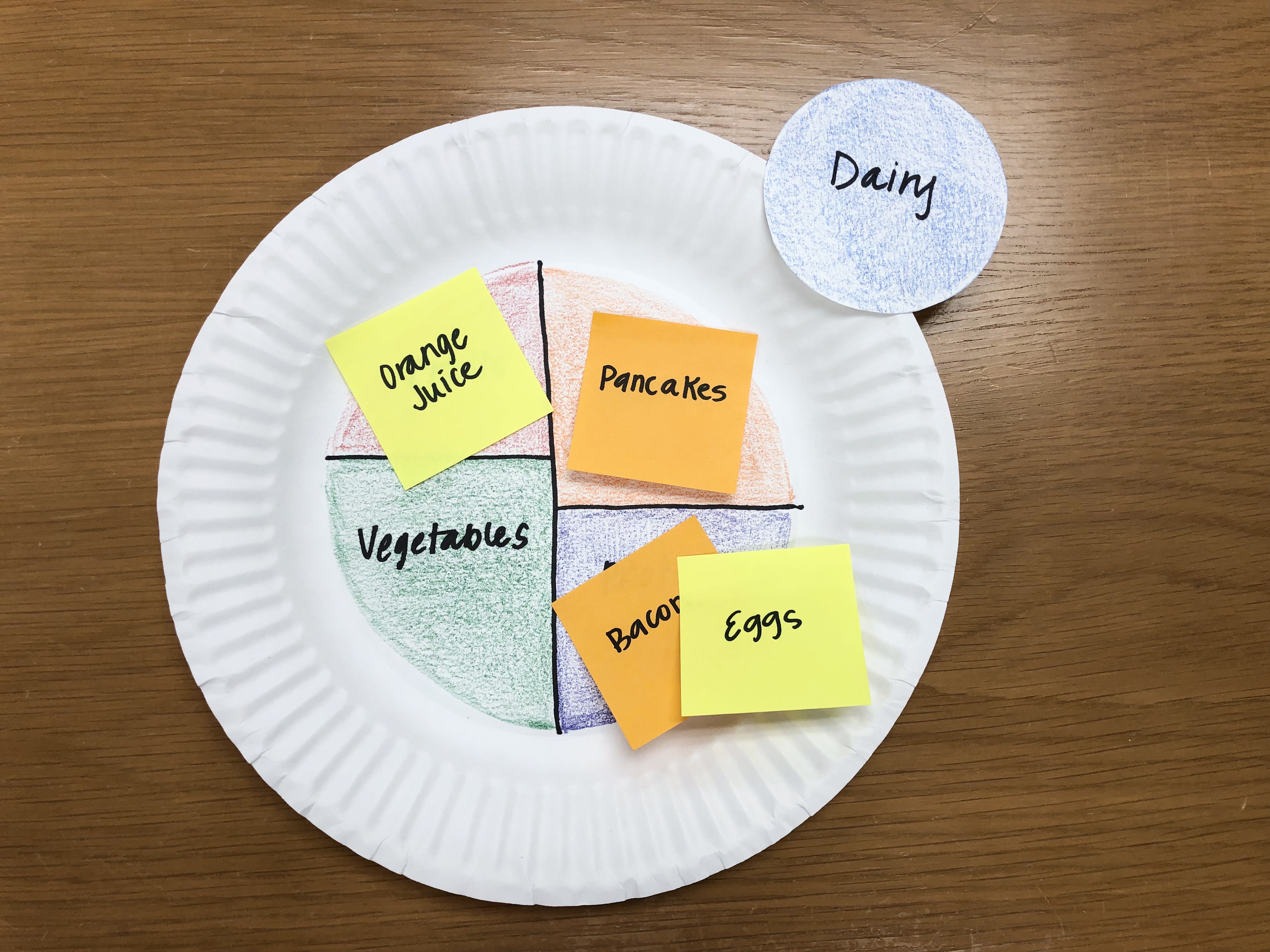
- Refer the students back to their sticky notes.
- Instruct the students to place each sticky note food item on their MyPlate, in the correct categories (e.g., place the pancake sticky note on the grains section, bacon on the protein section, etc.).
- Allow the students to stand and tell the class about their favorite meal and where they placed each food item.
- Lead a class discussion with the students.
- What food items make up your favorite meal?
- Does your favorite meal have a food item in each MyPlate category? A fruit, vegetable, grains, protein, and dairy?
- Are there sticky notes that don't have a place on MyPlate (e.g., syrup)? What does that mean for these food items?
- What categories (if any) are missing in your favorite meal?
- What could you add to your meal to balance your plate?
- Allow the students to add any sticky notes to the missing sections of their plate.
- Turn your students' attention to the word balanced.
- Discuss the importance of balance in a diet and making healthy choices.
- How do we choose a balanced meal?
- Why do we want a balanced meal?
Activity 2: Servings and Portions on MyPlate
- R
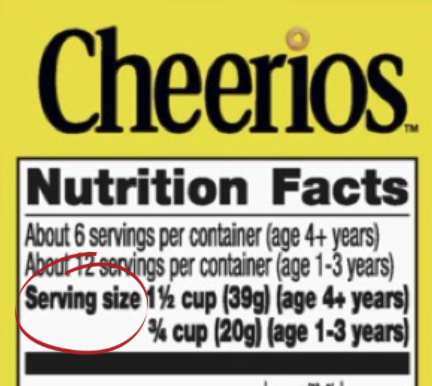 efer the students back to their favorite meals.
efer the students back to their favorite meals. - Ask the students to consider serving sizes.
- Ask your students, "What is a serving size?" (A serving size is a standard amount of food, such as a cup or ounce.)
- Now ask your students to think about portions. Ask, "What is a portion?" (A portion is the amount of food you are served or how much you eat.)
- Explain to the students the difference between serving sizes and portions. Serving size is a standard amount of food ( such as a cup or ounce). Serving sizes are commonly found on the Nutrition Facts Label. Some serving sizes have changed on the new Nutrition Facts Label. By law, serving sizes must be based on the amount of food people typically consume, rather than how much they should consume (e.g., the serving size for soda changed from eight ounces to 12 ounces because a person typically consumes a 12-ounce can of soda rather than eight).1 A portion (how much we eat) can be larger or smaller than a serving size.
- Clarify that the amount of food we eat from each category on MyPlate (fruits, vegetables, grains, proteins, and dairy) will depend on your age, gender, height, weight, and level of physical activity.
- Project the MyPlate Plan webpage on the board. This provides a basic plan for students ages 9-13. Remind the students again that the amount of food we eat from each category depends on our age, gender, height, weight, and physical activity. Explain that they may eat more or less depending on their activity level, and it's important to focus on eating when they are hungry and enjoying a variety of foods.
- As a class, view the general serving sizes for each of the food groups. Discuss with the students the difference between cups and ounces. If possible, provide visuals of how much a cup is and what 5-6 ounces looks like, or provide the students with a copy of How to Measure Food Using Your Hand.
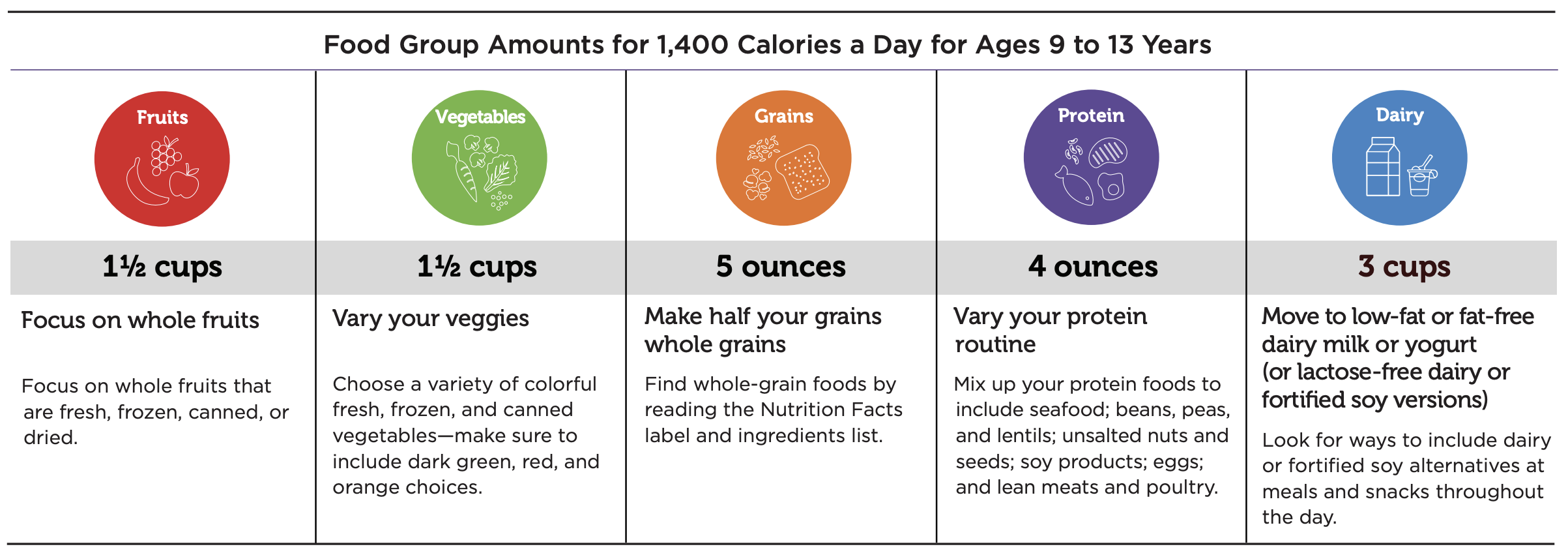
- Complete one of the following activities:
- The Food Models Kit is an excellent resource for providing a visual representation of serving sizes. This kit can be purchased from agclassroomstore.com or you may download the PDF and take it to a printing center. It is not suggested to print all the food model cards on a personal or school printer. If you do not wish to use Food Models, information about portion sizes can be found on myplate.gov, and serving size equivalents that are easy to visualize can be found on the Eating Well website.
- If using the Food Models, have the students find the cards that match their sticky notes. Students can group up with other students who have similar food items or meals.
- Point out that most of the serving sizes on the Food Models are measured in ounces or cups.
- Explain that each of the pictures are the actual size of that food item (e.g., the nonfat plain yogurt photo is the actual size of an 8-ounce container).
- Ask the students or groups of students to place each of their food models on their plate in the correct food group. If desired, allow students to add (or take away) food models to their meals.
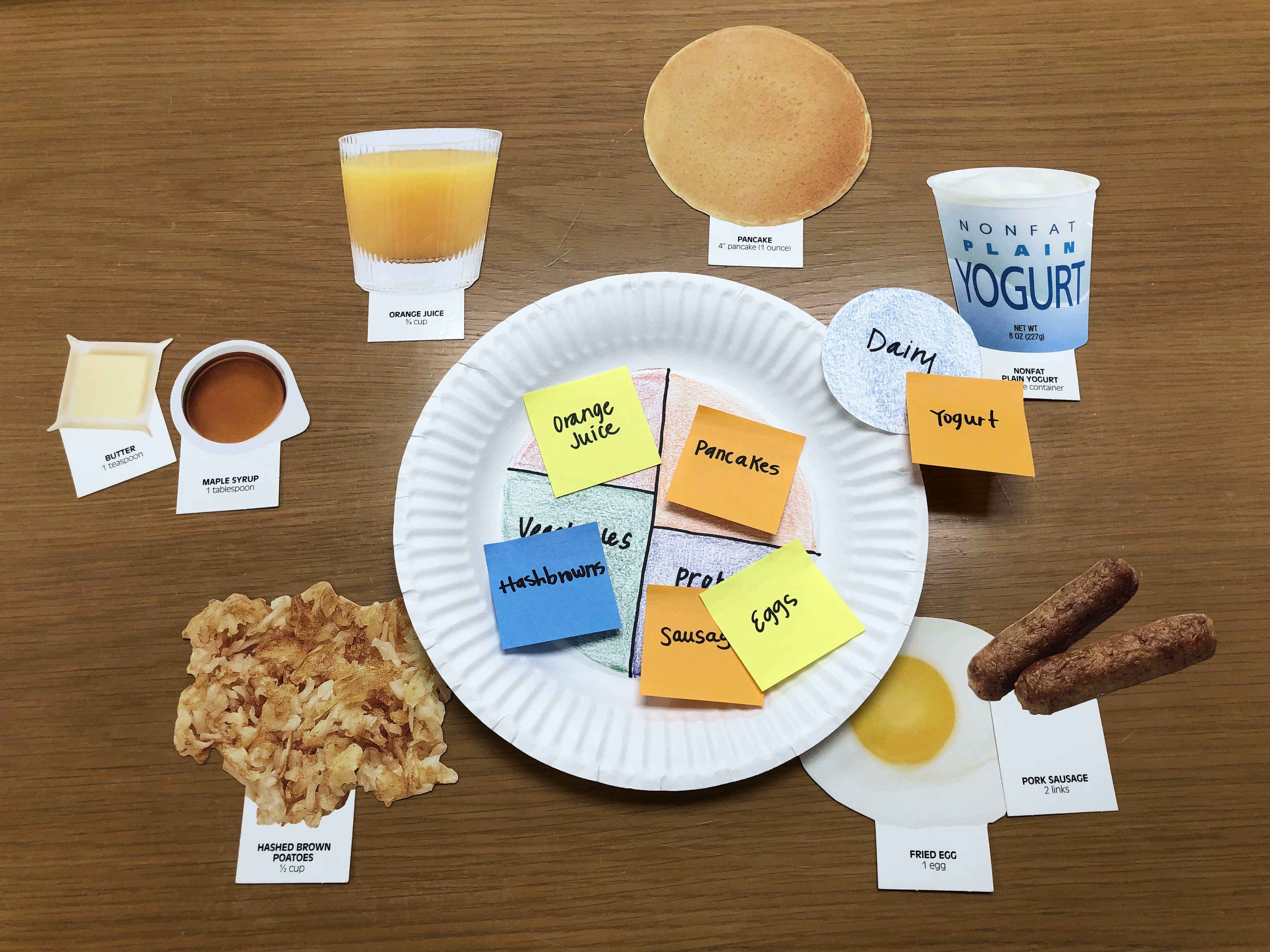
- For the students' reference, write on the board that there are 8 ounces in 1 cup.
- Ask the students to consider the serving size of each food model item and the daily food group amounts from the MyPlate Plan. Practice with the students using these examples: If the suggested dairy intake each day is 3 cups, and this yogurt (hold up the yogurt Food Model card) is 8 ounces, how much of my daily serving is yogurt? (The yogurt is 1/3 of my daily dairy servings.) If you eat a small pancake with a serving size of 1 ounce of grain and the daily suggested grains amount is 5 ounces, that pancake is 1/5 of your daily grain servings.
- Have the students complete the activities on the Healthy Choices activity sheet.
- Answer key to hamburger servings: bun = 2 grain servings, 1/2 cup onion and tomato = 1 vegetable serving, 1 oz. cheese = 2/3 milk serving, 3 oz. beef patty = 1 meat serving
- The Food Models Kit is an excellent resource for providing a visual representation of serving sizes. This kit can be purchased from agclassroomstore.com or you may download the PDF and take it to a printing center. It is not suggested to print all the food model cards on a personal or school printer. If you do not wish to use Food Models, information about portion sizes can be found on myplate.gov, and serving size equivalents that are easy to visualize can be found on the Eating Well website.
- Conclude by encouraging the students to try new foods, eat from all the food groups, and eat when they are hungry because some students may need more food than others for energy—especially if they are physically active. It is important to encourage a healthy relationship with food and not let students get overzealous with serving sizes and potentially restrict their intake when that is likely not needed at this age.
Activity 3: Think Your Drink
- Ask the students to name different drink choices, and list their responses on the board.
- Show the class some beverage containers. Ask the students how we can tell if drinks are healthy or not. Show the locations of the nutrition fact labels on the containers. Explain that we can look at the nutrition fact labels to determine whether or not drinks are healthy. These labels tell us what ingredients are inside our drinks and how many calories, sugars, fats, vitamins, and minerals the drinks contain.
- Provide each student with a copy of the Think Your Drink chart or project the chart for the whole class to see. Explain to the students that when choosing healthy drinks they should specifically consider the amount of calories and sugars compared to vitamins and minerals.
- Ask the students to use the Think Your Drink chart to determine which drinks on the class list are healthy choices. Explain that water, low-fat milk, and 100% juice are healthy drink choices. Water is essential for our bodies and contains no sugar or calories. Low-fat milk contains calcium which is important for overall health. When we aren’t getting enough calcium in our diets, our bodies take calcium from our bones, which causes our bones to weaken. 100% juice provides us with important vitamins and minerals, but also contains natural sugars. Daily intake of 100% juice should be limited to 8 ounces for adults and 4-6 ounces for children. Eating whole fruits is a better option for obtaining these vitamins and minerals.
Elaborate
-
Create a giant plate on one of your classroom walls. Ask students to cut out more magazine pictures or draw pictures of the foods that belong in each group and then place them on the wall. Alternatively, you may want to attach the actual containers to the appropriate food group. Consider asking students to bring in empty food containers.
-
Make a MyPlate snack. Have students invent a snack that includes foods from each food group. For example, start with half of an English muffin or a firm cracker. Spread the top lightly with peanut butter. Add shredded carrots and chopped apples. Serve with milk.
-
Identify the types of farms and the states where foods on the plate come from. Find out how long the crop or animal is grown to create an edible product delivered to your table.
-
Further explore the importance of a balanced diet in human health and what this means for vulnerable populations around the world using the lesson plan Hunger and Malnutrition.
-
Play the My American Farm interactive game Finders Keepers.
-
Read Issue 2 of Ag Today titled Food, Keeping us Fueled for an Active Lifestyle. This reader can be accessed digitally. Learn about the healthy and tasty food that farmers grow to help humans maintain a healthy diet. Follow the process from farm to plate and learn about serving sizes, food safety, and USDA's MyPlate.
Evaluate
After conducting these activities, review and summarize the following key concepts:
- A healthy diet includes fruits, vegetables, grains, protein, and dairy.
- Farmers produce the food we eat.
- It's important to eat the right amount of each food group to obtain the nutrients our body needs.
Recommended Companion Resources
- Ag Today
- AgBadging Field Guide
- Eat & Move O-Matic App
- Fill MyPlate Game
- Food Doesn't Grow in the Supermarket!
- Food Group Puzzle
- Food Models
- Good Enough to Eat: A Kid's Guide to Food and Nutrition
- Grains on MyPlate
- Higher or Lower: Ingredient Investigation
- How Did That Get in My Lunchbox?
- Jack & the Hungry Giant Eat Right with MyPlate
- Look Inside Food
- My American Farm
- MyPlate
- MyPlate Activity Poster
- Nutrition Posters
- Plants Feed Me
- Portion Size Comparison
- Sorghum: The Super Grain
- The Power of Choice Bulletin Board
- Who Grew My Soup?
Author
Organization
| We welcome your feedback! If you have a question about this lesson or would like to report a broken link, please send us an email at matrixelearning@gmail.com. If you have used this lesson and are willing to share your experience, we will provide you with a coupon code for 10% off your next purchase at AgClassroomStore. |
